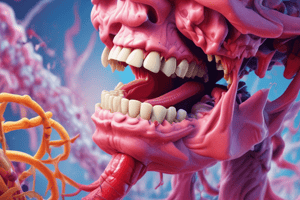Podcast
Questions and Answers
Which genetic mutation is most commonly associated with hypercoagulable states?
Which genetic mutation is most commonly associated with hypercoagulable states?
- Factor V Leiden mutation (correct)
- MTHFR gene mutation
- Prothrombin gene mutation
- Protein S deficiency
Which of the following is considered a secondary cause of hypercoagulability?
Which of the following is considered a secondary cause of hypercoagulability?
- Protein C deficiency
- Antithrombin deficiency
- Atrial fibrillation (correct)
- Factor V Leiden mutation
What is the effect of the Factor V Leiden mutation?
What is the effect of the Factor V Leiden mutation?
- Increased levels of protein S
- Decreased fibrinolysis
- Inhibition of prothrombin
- Resistance to activated protein C (correct)
Which of the following risk factors is categorized as having a strong risk for thrombosis?
Which of the following risk factors is categorized as having a strong risk for thrombosis?
Which hypercoagulable condition is characterized by a rare genetic deficiency?
Which hypercoagulable condition is characterized by a rare genetic deficiency?
A patient diagnosed with disseminated intravascular coagulation (DIC) is experiencing which type of hypercoagulable state?
A patient diagnosed with disseminated intravascular coagulation (DIC) is experiencing which type of hypercoagulable state?
Which of the following is NOT classified as a very rare inherited hypercoagulable condition?
Which of the following is NOT classified as a very rare inherited hypercoagulable condition?
Which of the following conditions is associated with a lower risk of thrombosis due to hypercoagulable states?
Which of the following conditions is associated with a lower risk of thrombosis due to hypercoagulable states?
What percentage of hospitalized patients is pulmonary embolism (PE) attributed to as a cause of death?
What percentage of hospitalized patients is pulmonary embolism (PE) attributed to as a cause of death?
From where do the majority of emboli that lead to pulmonary embolism originate?
From where do the majority of emboli that lead to pulmonary embolism originate?
What is the pathophysiological consequence of ventilating a non-perfused segment of lung due to pulmonary embolism?
What is the pathophysiological consequence of ventilating a non-perfused segment of lung due to pulmonary embolism?
What outcome is most likely when over 60% of the pulmonary circulation is obstructed by emboli?
What outcome is most likely when over 60% of the pulmonary circulation is obstructed by emboli?
Why does embolic obstruction of medium-sized pulmonary arteries usually not lead to infarction?
Why does embolic obstruction of medium-sized pulmonary arteries usually not lead to infarction?
Which of the following clinical symptoms is NOT typically associated with pulmonary embolism?
Which of the following clinical symptoms is NOT typically associated with pulmonary embolism?
What percentage of patients may develop pulmonary hypertension as a complication of repeated small thromboemboli?
What percentage of patients may develop pulmonary hypertension as a complication of repeated small thromboemboli?
What distinguishes systemic thromboembolism from pulmonary embolism?
What distinguishes systemic thromboembolism from pulmonary embolism?
What is the primary consequence of venous thrombosis that poses a life-threatening risk?
What is the primary consequence of venous thrombosis that poses a life-threatening risk?
What role does atherosclerosis play in arterial thrombosis?
What role does atherosclerosis play in arterial thrombosis?
Which statement correctly describes deep vein thrombosis (DVT)?
Which statement correctly describes deep vein thrombosis (DVT)?
What type of material primarily composes the majority of emboli?
What type of material primarily composes the majority of emboli?
Which factor is NOT typically considered a risk factor for developing deep vein thrombosis (DVT)?
Which factor is NOT typically considered a risk factor for developing deep vein thrombosis (DVT)?
What is considered the most common cause of death in Western industrialized countries related to arterial thrombosis?
What is considered the most common cause of death in Western industrialized countries related to arterial thrombosis?
Which of the following correctly defines embolism?
Which of the following correctly defines embolism?
Approximately how many people in the U.S. are impacted by pulmonary embolism (PE) each year?
Approximately how many people in the U.S. are impacted by pulmonary embolism (PE) each year?
Which organs have dual circulation and are less affected by small occlusions?
Which organs have dual circulation and are less affected by small occlusions?
What is the primary factor influencing whether a vessel occlusion leads to infarction?
What is the primary factor influencing whether a vessel occlusion leads to infarction?
Which type of tissue is most vulnerable to hypoxia and can undergo irreversible change quickly?
Which type of tissue is most vulnerable to hypoxia and can undergo irreversible change quickly?
How long can cardiac myocytes withstand ischemia before dying?
How long can cardiac myocytes withstand ischemia before dying?
What is a significant consequence for patients with anemia or pulmonary disease regarding vessel occlusion?
What is a significant consequence for patients with anemia or pulmonary disease regarding vessel occlusion?
Which of the following statements about collateral circulation is accurate?
Which of the following statements about collateral circulation is accurate?
What happens to fibroblasts in myocardium during ischemic conditions?
What happens to fibroblasts in myocardium during ischemic conditions?
Which of the following factors plays an essential role in determining the outcome of vessel occlusion?
Which of the following factors plays an essential role in determining the outcome of vessel occlusion?
What is the primary characteristic of an infarct?
What is the primary characteristic of an infarct?
Which type of infarct is most likely to occur in organs with end-arterial circulation?
Which type of infarct is most likely to occur in organs with end-arterial circulation?
What is one of the potential causes of infarction besides thrombotic events?
What is one of the potential causes of infarction besides thrombotic events?
Which setting typically leads to the occurrence of red infarcts?
Which setting typically leads to the occurrence of red infarcts?
What percentage of deaths in the U.S. are attributed to infarction?
What percentage of deaths in the U.S. are attributed to infarction?
Which of the following symptoms is NOT characteristic of the severe condition described?
Which of the following symptoms is NOT characteristic of the severe condition described?
Which type of blood supply scenario is most likely to lead to the formation of white infarcts?
Which type of blood supply scenario is most likely to lead to the formation of white infarcts?
What is the estimated occurrence rate of the severe condition in pregnancies?
What is the estimated occurrence rate of the severe condition in pregnancies?
Flashcards are hidden until you start studying
Study Notes
Hypercoagulable States
- Hypercoagulable states are alterations in coagulation pathways leading to thrombosis.
- Causes classified as primary (genetic) or secondary (acquired).
Primary (Genetic) Causes
- Common:
- Factor V Leiden mutation: point mutation leads to thrombotic risk.
- Prothrombin gene mutation: affects blood clotting.
- MTHFR gene mutation: involved in folate metabolism.
- Rare:
- Antithrombin deficiency: increases risk of clots.
- Protein C and S deficiency: impair natural anticoagulation.
- Fibrinolysis defects: issues with clot breakdown.
Secondary (Acquired) Causes
- Strong Risk:
- Prolonged bed rest or immobilization: increases venous thromboembolism risk.
- Myocardial infarction and atrial fibrillation: alter fluid dynamics, increasing thrombosis likelihood.
- Surgery, trauma, burns: lead to tissue damage promoting coagulability.
- Cancer: releases pro-coagulant factors.
- Prosthetic cardiac valves: disrupt normal blood flow.
- Disseminated intravascular coagulation (DIC): leads to widespread clotting.
- Lower Risk:
- Cardiomyopathy, nephrotic syndrome, hyperestrogenic states (e.g., pregnancy), oral contraceptive use, sickle cell anemia, smoking.
Venous Thrombosis
- Most commonly occurs in superficial or deep leg veins (SVT or DVT).
- Superficial Thrombosis Symptoms: swelling and pain, rarely embolize.
- Deep Vein Thrombosis Symptoms: pain, redness, swelling; potentially asymptomatic due to collateral circulation.
- DVT Risk Factors: stasis and hypercoagulable states.
Embolism
- Embolism is the transportation of material through the vascular system that occludes a distant vessel.
- Majority are thromboemboli; rarer types include fat globules, gas, and amniotic fluid.
Pulmonary Embolism (PE)
- Affects approximately one million people annually in the U.S., with 100,000-200,000 fatalities.
- 95% of PE cases originate from DVT.
- Size of the embolus affects location and degree of obstruction in the pulmonary artery.
- Consequences:
- Respiratory compromise from non-perfused lung segments.
- Hemodynamic compromise due to increased resistance.
- Clinical Symptoms: chest pain, cough, shortness of breath, tachycardia, tachypnea.
- Outcomes can include sudden death, right heart failure, or pulmonary hypertension.
Systemic Thromboembolism
- Characterized by emboli within the arterial circulation leading to respiratory distress and neurological symptoms.
- Significant maternal mortality risk associated with thromboembolisms in pregnancy.
Infarction
- An infarct is ischemic necrosis from occluded arterial supply or venous drainage.
- Major causal factors include thrombotic/embolic events (99% of cases).
Types of Infarcts
- White (pale) Infarcts: occur with artery occlusion in organs with little collateral circulation (e.g., heart, kidney).
- Red Infarcts: mainly due to venous occlusion or dual blood supply allowing some blood flow.
Factors Influencing Infarction
- Availability of alternative blood supply: organs like lungs and liver less sensitive to small occlusions.
- Rate of occlusion development: slow occlusions allow time for collateral circulation formation.
- Tissue vulnerability to hypoxia: neurons sensitive to ischemia (change in 3-4 min), cardiac myocytes (20-30 min).
- Oxygen content of blood: anemia and pulmonary disease increase susceptibility to infarction.
Studying That Suits You
Use AI to generate personalized quizzes and flashcards to suit your learning preferences.


